Updated: 4th February 2024
❚ The bikes highlighted in this post are chosen or evaluated independently by myself. If you make a purchase through links on our website, we might receive an affiliate commission. However, this never sways our objective perspective or recommendations.
Steel gravel bikes offer a unique ride quality, with a natural ability to absorb vibrations they offer a smooth ride, especially on rough terrains making them great bikes for off-road adventures.
The Short Verison
I don’t know about you but for me, I personally love the classic, timeless look that steel gravel bikes achieve! Some of the most aesthetically pleasing bikes you can buy.
Although steel bikes are rather heavier than lighter materials on the market. This material offers durability and strength. This is why traditional touring bikes are made from steel. It can take a beating and still maintain its structural integrity, making it great for rugged adventures.
In the unfortunate event of damage, steel frames are generally easier and more cost-effective to repair than carbon or aluminum. If you are traveling and the frame breaks you can generally get a local welder, to repair it and be on your way.
But from my own personal experience, I am a sucker for steel gravel bikes because of their ride quality. They just have this natural ability to absorb vibrations, offering a smoother ride, especially on rough terrains like gravel roads.
I noticed the difference when I got my own steel gravel bike. It was a big shift in ride feel!
Steel is a dream material for adventure and gravel bikes. Yes, it can be a heavier material when compared to aluminum and titanium. But for this article, we are focusing strictly on gravel bikes that are made of steel.

Some bikes are in the grey area of gravel bikes and adventure or touring bikes, like the Kona Sutra LTD.
The bikes listed below are all road gravel riding machines made from steel. This article might be helpful if you are after Monstercross bikes or 650b gravel bikes.
Watch while you read: Check out our latest video on Fast Adventure Bikes, made specifically for endurance events like the Tour Divide. Some of these bikes are made from steel and also provide fast riding. Which is often something not associated with steel bikes as they are typically heavier then carbon.
Also, read more about; some of the best Drop Bar Mountain bikes here.
If titanium is more your style, here are some of the best Ti Gravel bikes.
Here at Cycle Travel Overload, we are all about that! Adventure by bike! These gravel bikes are more than capable of holding up to your demands for bikepacking adventures on and off-road.
My Steel Gravel Bike
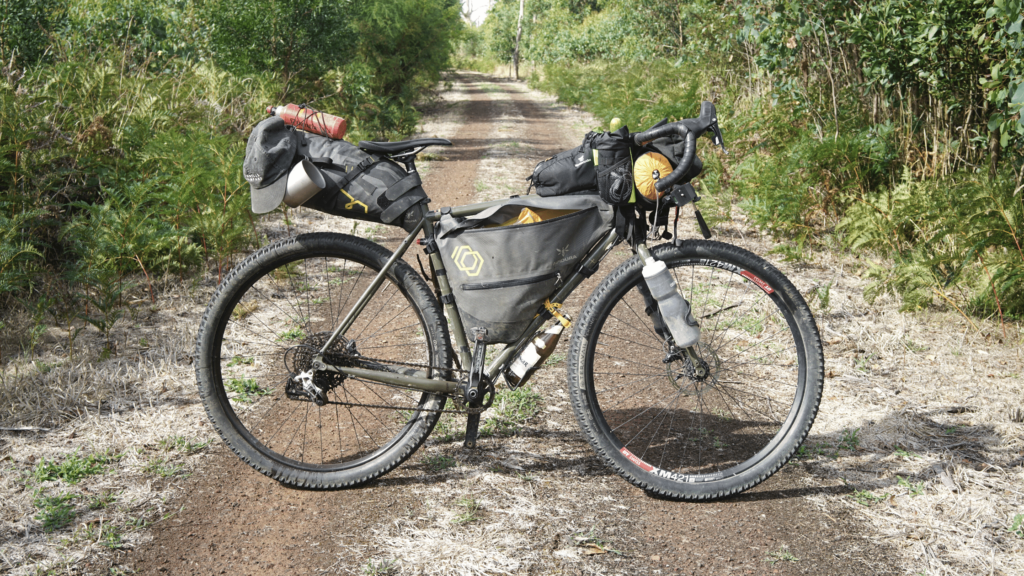
Throughout the last ten years, my cycling quests have led me across diverse landscapes and through numerous adventures, all atop bicycles with steel frames.
This material has consistently been by my side during these excursions, ultimately becoming my material of choice for adventure cycling.
WATCH MY REVIEW
Starting with journeys on a classic touring bike, moving through explorations on a Surly LHT, and presently adventuring with a Kona Sutra LTD, each of these steel companions has demonstrated its value.
With this extensive experience, I can assert with confidence that for durability, comfort, and peak performance, there’s no match for steel bikes.
Indeed, in the realm of adventure cycling, steel bikes stand out
Niner RLT 9 Steel
(Lightweight steel gravel bike)
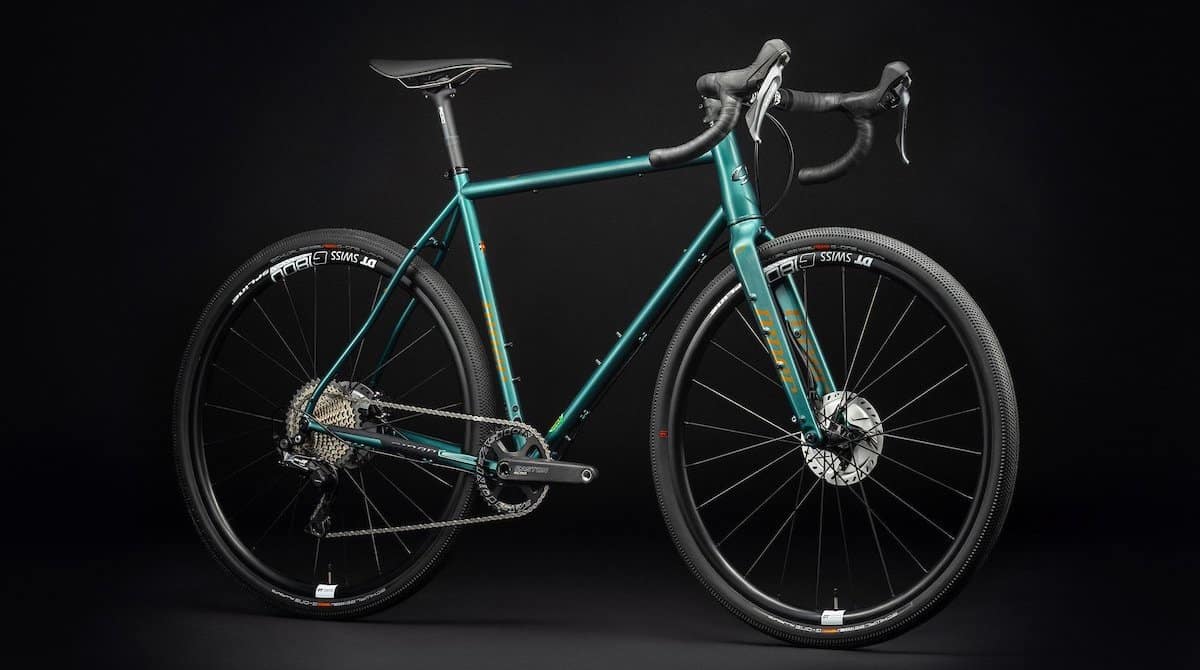
| Spec | Value |
| Price | From $3,299 |
| Weight | 23.2 pounds (10.5 kg) |
| Low Gear Ratio (Climbing) | 28″ |
| High Gear Ratio | 105″ |
| Groupset / Component Spec Level | Upper-Mid |
| Tire Clearance | 50 mm or 2″ |
| Upright Ranking (Stack/Reach Ratio) | 1.55 (Average Upright) |
| Front Ride Feel (Trail) | 70 (High/Stable) |
| Rear Ride Feel (Chainstay) | 435 (Mid/All-Rounder) |
Designed for adventure and versatility, the RLT 9 Steel by Niner is built from a Reynolds 853 Steel frame and an RDO carbon fork, adding extra suppleness off-road.
Key upgrades encompass a novel carbon fork, sleek internally routed cables, flat mount brakes, and added three-pack mounts on the fork legs.
🏷️ 🎁 🔥 SAVE 33% get the 2023 NINER RLT STEEL RDO 2-STAR for ONLY $2,099.94 – WAS $3,149.00!!
At the bike’s heart is a Reynolds 853 steel frame paired seamlessly with Niner’s RDO carbon fiber fork. It provides ample tire clearance, accommodating 700 x 50mm or 650b x 2.0″ sizes.
What’s particularly enticing for the adventurous rider is its versatile mounting provisions, tallying up to 26 distinct options to accommodate racks, fenders, and bolt-on bags.
And for those craving an adrenaline-filled ride, it comes ready for dropper post-integration.
Niner’s offering scope for the RLT 9 Steel will include both a standalone frame option and a diverse range of complete builds, with price points spanning from just below $3,000 to approximately $6,000 USD.
Still deciding between bikes like Sami?

Choosing the right bike can be overwhelming – but it doesn’t have to be.
Join the Bike Buyers Masterclass
A 2-hour step-by-step guide that helps you confidently choose your perfect adventure bike, just like Sami did.

Simplify specs. Avoid costly mistakes. Get support from 3,000+ others.
Plus: Win up to $500 in gear, score exclusive discounts, and join our private community.
Mason InSearchOf
(Steel gravel bike with large tire clearance)

(Endurance Event Gravel Crusher)
| Spec | Value |
| Price | From $3,976 |
| Weight | 24.25 pounds (11 kg) |
| Low Gear Ratio (Climbing) | 22″ |
| High Gear Ratio | 94″ |
| Groupset / Component Spec Level | Upper-Mid |
| Tire Clearance | 650b x 2.8″ or 29″ x 2.6″ |
| Upright Ranking (Stack/Reach Ratio) | 1.65 (Upright) |
| Front Ride Feel (Trail) | 73 (High/Sluggish) |
| Rear Ride Feel (Chainstay) | 445 (Mid-Long/Chill) |
Featured as on of the top 10 bikes from this years Tour Divide race!
This rig is available in some nice build options with about 4 models to choose from all starting from $3,864 (Rival 1x).
This has to be one of the most capable-looking drop bar bikes upon first impression.
The ultimate steel adventure bicycle has been adopted by the Ultra-Endurance community realizing the comfortable, fast, multi-surface capabilities of this bike making it ideal for such Continent Crushing rides. Much so that Josh Ibbett won the 2015 Trans Continental race on a Mason.
The frame is composed of custom-formed Progressive-butted Dedacciai ‘Zero’ Steel tubing which is used on the Top Tube, Down Tube, Seat Stays, and Chain Stays. While the Seat Tube uses Reynolds 853 steel and a Stainless bottom bracket.
There is plenty of clearance and the bottom of the down tube for mounting gear like the ‘Anything Cage‘ style bosses on top of and underneath the Down Tube.
The geometry has been suspension fork corrected for up to 100mm of travel if you want that extra comfort on the rough stuff.
However, it comes with the Hot Shoes fork which is internally routed for dynamo light systems and eyeletted for rack and mudguards. With all the mounting options you could ask for up front. You also get a Shutter Fender which is exclusive to Mason
The frame is also stealth dropper compatible, with a max tire clearance for up to 29 x 2.4” or 27.5 x 2.8” tires. Comes with the Ritchey Venturemax Comp handlebars that have a generous 24 deg flare for that extra comfort in the drops.
Panorama Taiga EXP
(Steel gravel bikes made in Canada)
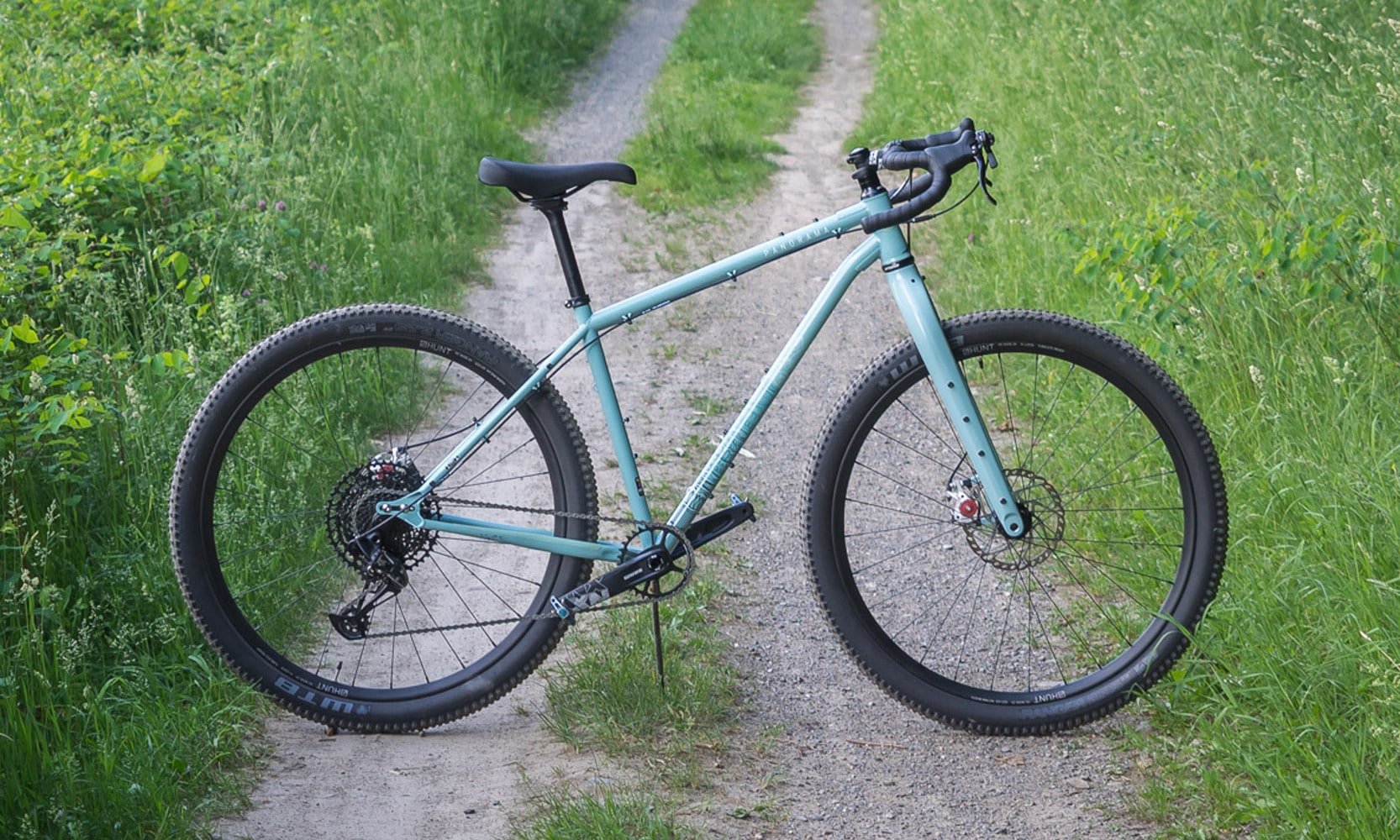
(A true do-it-all steel gravel bike – Adventure Ready!)
| Spec | Value |
| Price | From $2,667 |
| Weight | 25 pounds (11.34 kg) |
| Low Gear Ratio (Climbing) | 20″ |
| High Gear Ratio | 90″ |
| Groupset / Component Spec Level | High-End |
| Tire Clearance | 29 x 2.6″ |
| Upright Ranking (Stack/Reach Ratio) | 1.67 (Very Upright) |
| Front Ride Feel (Trail) | 95 (High/Sluggish) |
| Rear Ride Feel (Chainstay) | 450 (Long/Chill) |
Quebec’s Panorama Cycles, which made a significant mark with their steel hardtail mountain bike, the Taïga, has now unveiled its drop-bar counterpart: the Taïga EXP.
Retaining much of the charisma of its predecessor, the Taïga EXP diverges with a design tailored for drop bars, creating an adventure bike that’s both rugged and versatile.
Crafted around a sturdy Reynolds 725 steel frame complemented by a carbon fork, the Taïga EXP is an emblem of adaptability. It showcases a plethora of mounting points, accommodating everything from the essentials to adventure gear.
I got the chance to meet Simon and Louise from Panorama in this video (Truly amazing people!)
Some notable features include triple-pack mounts, downtube bosses, and provisions for a bolt-on top tube bag. But its versatility doesn’t end there.
The bike also boasts sliding dropouts, compatibility for belt-drive systems, 100mm travel suspension-corrected geometry, and internal dynamo routing on the fork, ensuring it’s equipped for various terrains and ride preferences.
For those interested in the specifics, the Taïga EXP’s build kit doesn’t disappoint. At its core are the Gevenalle GX shifters, coupled with an NX Eagle 12-speed drivetrain and sturdy HUNT XC Wide wheels. It ensures smooth stops with Avid BB7 mechanical brakes and offers comfortable control with a 52cm wide Ritchey Beacon handlebar.
While it comes standard with 29 x 2.25″ WTB Rangers, popular among bikepackers, those looking for a wider grip will appreciate its capacity to accommodate up to 2.6″ tires.
Cotic Cascade

(29er Drop bar Steel Gravel Bike Beast)
| Spec | Value |
| Price | From $2,151 |
| Weight | 23.2 pounds (10.5 kg) |
| Low Gear Ratio (Climbing) | 18″ |
| High Gear Ratio | 93″ |
| Groupset / Component Spec Level | Upper-Mid |
| Tire Clearance | 2.4″ (rear) & 2.6″ (front) |
| Upright Ranking (Stack/Reach Ratio) | 1.52 (Average) |
| Front Ride Feel (Trail) | 79 (High/Sluggish) |
| Rear Ride Feel (Chainstay) | 438 (Mid/Chill) |
The Cotic Cascade has been making waves since its introduction, especially in the ever-evolving world of the drop-bar 29er.
This UK-based brand’s offering stands out not merely because it’s a steel bike but for its distinct design nuances. Cotic has ventured to fit this bike between the SolarisMAX hardtail mountain bike and the Escapade all-road road/gravel bike in their lineup.
This makes the Cascade a versatile entity that can be configured in various ways – with a carbon fork for a lighter touch, a solid steel fork for ruggedness, or even a 100mm travel suspension fork and a dropper post for those seeking more adventure.
Material & Build: The Cascade is crafted from steel – a hallmark of Cotic. The frame uses a blend of Reynolds 853 steel for its “Ovalform” top tube and 34.9mm seat tube, coupled with 4130 Chromoly steel for its wishbone seat stays, and bridgeless S-bend chainstays.
Specifications: The bike supports Boost hub spacing with ample tire clearance – up to 29 x 2.4″ at the rear and 2.6″ up front, and can also accommodate 27.5 x 2.8″ or 3.0″ tires. Unique dropouts, frame bag bosses, fender mounts, and other accessories make it a bike designed for customization and adaptability.
Choices: Cotic gives you options when it comes to the Cascade’s fork. You can go with their steel Alpaca fork, a carbon Salsa Firestarter, or a Rockshox SID SL Ultimate 100mm travel fork. Additionally, the frameset is available in three colors and four sizes to cater to individual tastes and needs.
Pricing: You can get the Cascade’s frame and steel fork for about $1,050 USD. However, a complete build, customizable to your preference, starts at approximately $2,600 USD.
Performance: The Cascade prides itself on being confident and sure-footed, especially on descents, singletrack trails, and gravel roads. Its long reach, high trail, and unique Sureshot geometry give it a unique riding experience. However, certain components, like the handlebars and tires, might need tweaks depending on the trail’s demand. When configured right, this bike is built for both speed and technical challenges.
Comparison: Compared to other bikes like the Tumbleweed Stargazer, the Cascade brings in its Sureshot geometry, which greatly affects its reach. It’s one of the longer drop-bar bikes out there, designed around a short stem with drop bars, making it a prime candidate for both drop and flat bars.
On the Trail: The Cascade is known for its mountain bike-like demeanor. It’s agile and playful, more like a spry XC bike but with the stability and control of a rugged mountain bike. Its frame offers impressive comfort, thanks to a balanced and compliant tubeset.
Marin Nicasio +
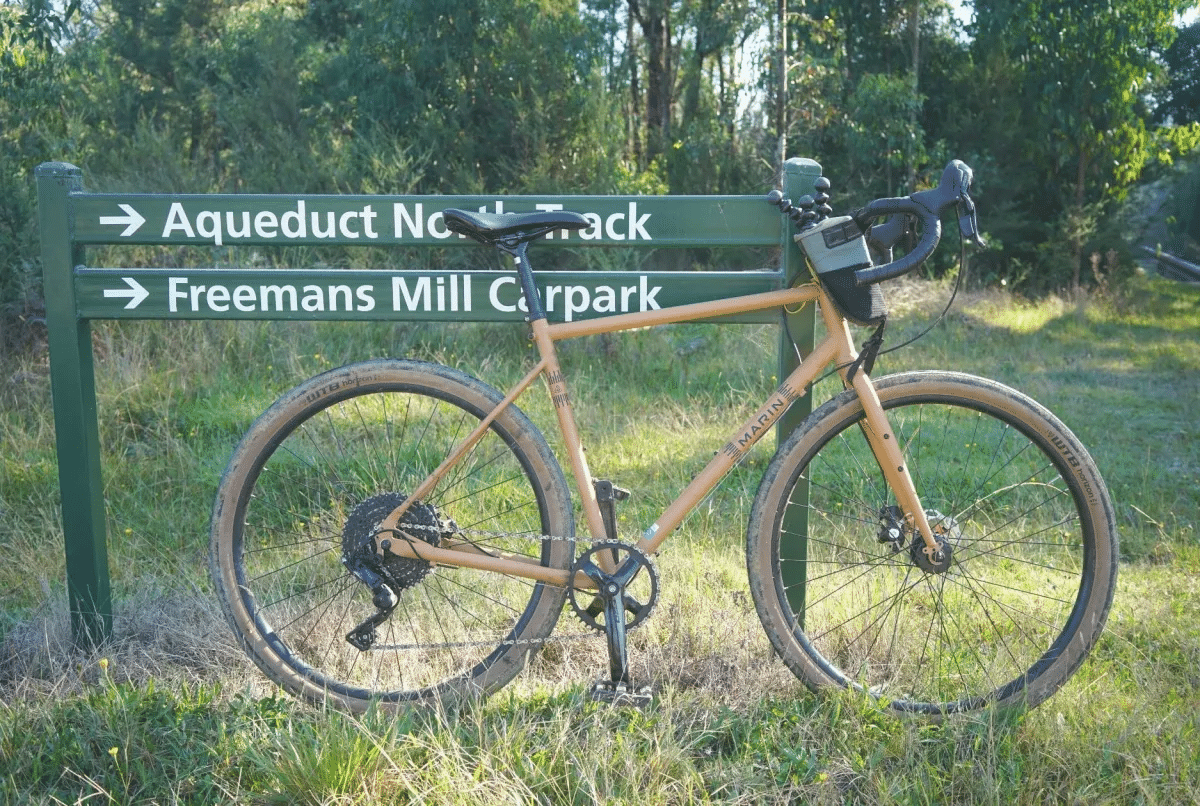
(Budget-Friendly Steel Gravel Bike)
| Spec | Value |
| Price | From $1,099 |
| Weight | 28.88 pounds (13.1 kg) |
| Low Gear Ratio (Climbing) | 25″ |
| High Gear Ratio | 105″ |
| Groupset / Component Spec Level | Mid |
| Tire Clearance | 700C x 40mm or 650B x 47mm |
| Upright Ranking (Stack/Reach Ratio) | 1.52 (Average) |
| Front Ride Feel (Trail) | 63 (Mid-Predictable) |
| Rear Ride Feel (Chainstay) | 420 (Short/Jumpy) |
The Marin Nicasio + serves as an introduction to the realm of gravel riding. Falling under Marin’s drop bar gravel category, it offers a blend of endurance road handling with enhanced stability for off-pavement use.
Although criticized by some for its weight, the bike’s Series 1 Double Butted CrMo Beyond Road frame provides exceptional strength, making it a favorite for many.
Read our full Marin Nicasio + Review here
However, its tire clearance limitation means it’s more suited for lighter gravel roads and simpler off-road terrains.
While equipped with mid-range components like Tektro Road brakes and a MicroSHIFT Advent groupset, its affordability means some trade-offs in higher-end components.
When compared to other gravel bikes in its price range, the Nicasio + ranks reasonably well, particularly for those on a budget or those venturing into gravel biking
After testing out this bike, I noticed a difference in ride quality compared to my $3,000 adventure steel gravel/touring bike which is purposely built for adventure.
This is mainly due to the geometry with a shorter rear end when compared to other gravel bikes, it just lacks supreme stability especially when carrying gear.
The Nicasio did lack a more stable feel. It wouldn’t be my go-to for hardcore drop bar adventures. That’s why for the price we can recommend it as an entry-level steel gravel bike. Having that said so many Nicasio enthusiasts have taken this bike on some rad adventures.
Bombtrack Beyond SUS
(Steel gravel bike with suspension)

(Suspension Steel Adventure Gravel Bike)
| Spec | Value |
| Price | From $1,900* |
| Weight | 27 pounds (12.25 kg) |
| Low Gear Ratio (Climbing) | 25″ |
| High Gear Ratio | 95″ |
| Groupset / Component Spec Level | Mid |
| Tire Clearance | 2.1″ |
| Upright Ranking (Stack/Reach Ratio) | 1.60 (Upright) |
| Front Ride Feel (Trail) | 75 (High/Stable-Sluggish) |
| Rear Ride Feel (Chainstay) | 455 (Long/Stable) |
| Fork | Hardtail, 40mm |
Looking for a steel gravel bike with suspension? The Beyond by Bombtrack. From the heart of Cologne, Germany, unveils four newly updated models, enhancing their 2023 collection.
This release includes refined versions of their acclaimed Beyond series, a premium edition of their steel Hook EXT that now boasts electronic shifting and a value-driven variant of their practical Arise model.
We are highlighting the Beyond Suspension model, however, the Hook EXT is still a great choice.
The Beyond SUS stands out, equipped with the RockShox Rudy suspension fork, ensuring riders face minimal disruptions on any terrain.
Functionality is front and center with the frame’s adaptable mounting options—ranging from top tube mounts to multiple cage mounts on the downtube.
Powering this model is the Sram Apex 1×11 groupset, accompanied by a wide-ranging 11 – 42T cassette. The bike sits on tubeless-ready WTB ST i23 rims and WTB Venture Light tires for swift and silky rides.
For those unexpected on-trail hiccups, the Bombtrack Tau 12mm through-axle hubs promise quick fixes.
Priced at $2,789 (or 2,699€), the Beyond SUS offers five size variations from XS to XL. Comprehensive specifications and geometry insights are accessible on Bombtrack’s official website.
Rose Hobo
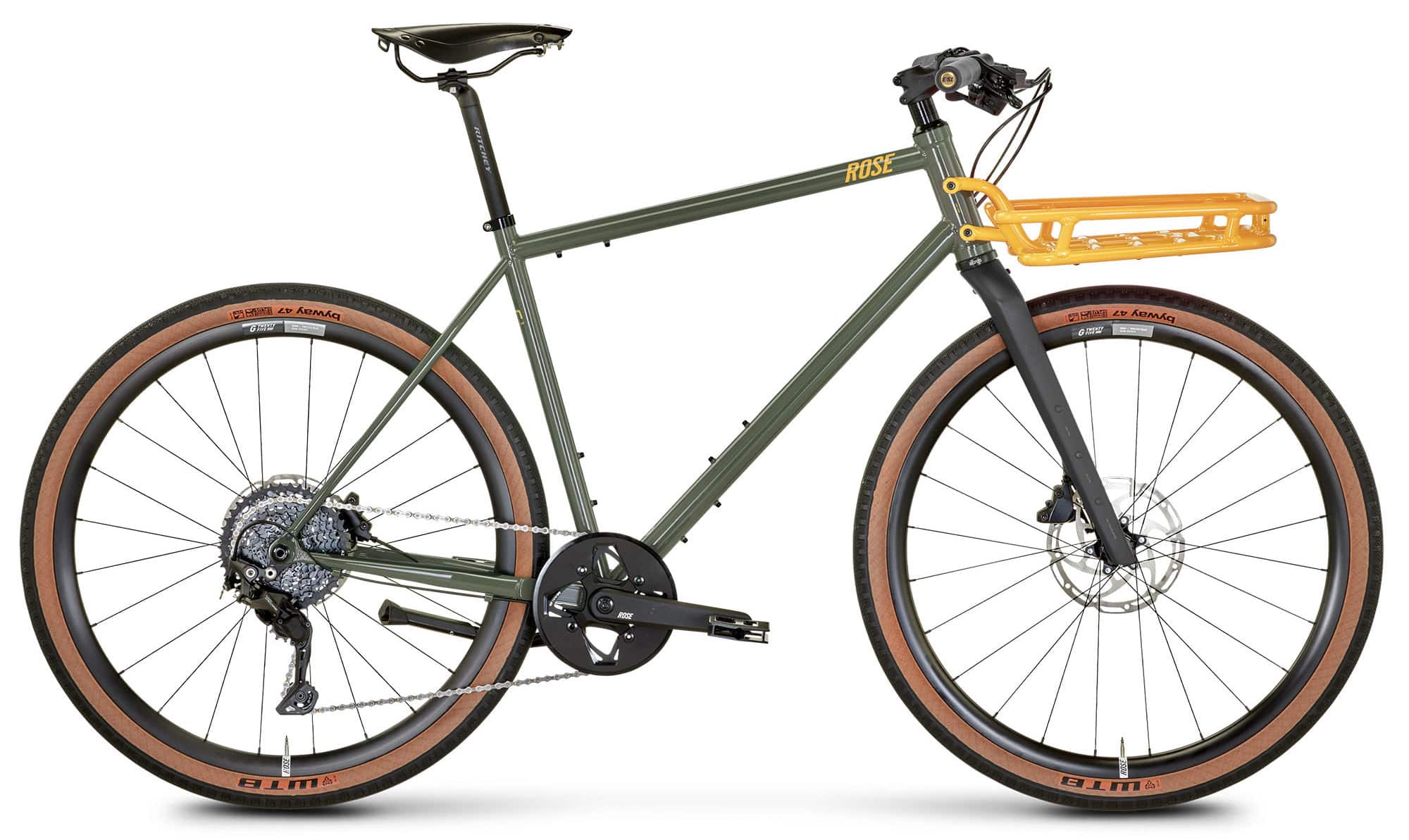
(Modern Hybrid Steel Gravel Bike)
| Spec | Value |
| Price | From $1,757 |
| Weight | 25.8 pounds (11.70 kg) |
| Low Gear Ratio (Climbing) | 28″ |
| High Gear Ratio | 105″ |
| Groupset / Component Spec Level | Upper-Mid |
| Tire Clearance | 650b x 2.1″ |
| Upright Ranking (Stack/Reach Ratio) | 1.46 (Average – Flat Bar) |
| Front Ride Feel (Trail) | 73.4 (High/Stable) |
| Rear Ride Feel (Chainstay) | 420 (Short/Jumpy) |
Making another appearance as one of the nicer flat bar gravel bike choices for this year, with some fun features, like that front rack!
The Rose Hobo is a fusion of retro charm and contemporary tech, marking Rose’s reentry into steel-framed bikes. Here’s a succinct look at what makes this gravel commuter a standout:
Design Philosophy: This bike strikes a balance between the past and the present. Dubbed a “hybrid”, the Rose Hobo has reinvented the term with improved tire clearance, effective brakes, efficient 1x drivetrains, and a plethora of braze-on mounts.
Build and Features: Made with a durable 4130 chromoly steel frame, the Hobo comes with a full carbon fork and an ergonomic 14° backsweep flat handlebar, coupled with ESI Chunky silicone grips. Notably, it introduces a modular front rack that can be direct-mounted to the side of the headtube.
Rack Options: An array of choices for its modular rack system includes a narrow traditional front rack, a broad porteur-style rack (the size of a pizza box), and a specialized front rack bag. This bag doubles as a backpack and even features a detachable insulated liner, perfect for post-ride refreshments or grocery shopping.
Geometry: The Hobo offers a mix of nimble and stable riding dynamics. The geometry promotes an upright, relaxed ride, thanks to short chainstays combined with an extended Reach and a tall Stack.
Technical Specs: Modern design elements like a 44mm headtube for tapered forks, internal cable routing, flat mount disc brakes, and 12mm thru-axles are incorporated. But it also respects tradition with features like a 27.2mm round seatpost, a threaded BSA bottom bracket, and a mid-bike kickstand. Storage and utility are prioritized with multiple cage mounts and full fender compatibility.
Tire Clearance: Designed with gravel riders in mind, the Hobo can accommodate up to 650b x 2.1″ tires. Though intended for 650b wheels, there’s enough room to swap in larger 700c gravel tires if desired.
Pricing and Variants: Three affordable builds are available. The basic Shimano Deore 10sp is priced at 1600€ and weighs 11.7kg. The GRX810 11sp variant is priced at 1800€, shaving off 100g in weight. A limited edition SRAM Rival eTap AXS XPLR wireless 1×12 is also available for 3000€.
Accessories: A holistic Hobo experience involves its unique accessories. The dual-mode Hobo rack costs an extra 150€, the Hobo Rack Bag is 100€, custom Hobo fenders by SKS are priced at 40€, and the Knog Blinder MOB lights come in at 100€.
In a nutshell, the Rose Hobo brings the best of the hybrid world, modernized for today’s urban and gravel riders, all at a value-conscious price point. Customize it further with exclusive accessories to make it uniquely yours.
Standert Erdgeschoss Stainless

(Stainless Steel Steed of Beauty)
| Spec | Value |
| Price | From $4,130 |
| Weight | 1980g (54cm), plus 535g Carbon fork |
| Groupset / Component Spec Level | Upper-Mid |
| Tire Clearance | 700c x 50mm or 650b x 54mm |
| Upright Ranking (Stack/Reach Ratio) | 1.43 (More aggressive) |
| Rear Ride Feel (Chainstay) | 425 (Short/Quick) |
German bike brand Standert has reintroduced its Erdgeschoss adventure gravel bike, which sold out quickly after its debut last summer. A stainless steel build, with an updated version offering new paint job options and a more affordable Shimano GRX build kit option.
It is designed to cater to various riding styles, from casual gravel rides to bikepacking adventure racing. The bike features big tire clearance, updated and adjustable geometry, and integrated dynamo routing.
The tech details of the Standert Erdgeschoss include a Columbus Futura Cross+ carbon fork with a flip-chip at the axle, allowing riders to switch between 700c x 42mm tires with a 52mm offset for fast gravel riding and 650b x 2″ tires with a 47mm offset for off-road adventures.
The fork also includes internal dynamo wiring routing, matching the internal routing in the frame. The bike is equipped with sliding dropouts that enable riders to lengthen the wheelbase for increased off-road stability or shorten it for more agile handling.
The dropouts also future-proof the bike for changing axle/derailleur standards or singlespeed builds. The Standert Erdgeschoss offers ample tire clearance for 650b x 54mm or 700c x 50mm tires.
The bike comes in seven stock sizes from 48cm to 60cm, with optimized geometry on the three smallest sizes.
The frame features a straight headtube, modular internal cable routing compatible with various drivetrain configurations, a T47 bottom bracket shell, flat mount disc brakes, 12mm thru-axles, and a standard 27.2mm seatpost.
It includes multiple mounting options for cages and racks, as well as provisions for full-coverage fenders
Battaglin Portofino G
(Custom steel gravel bikes)
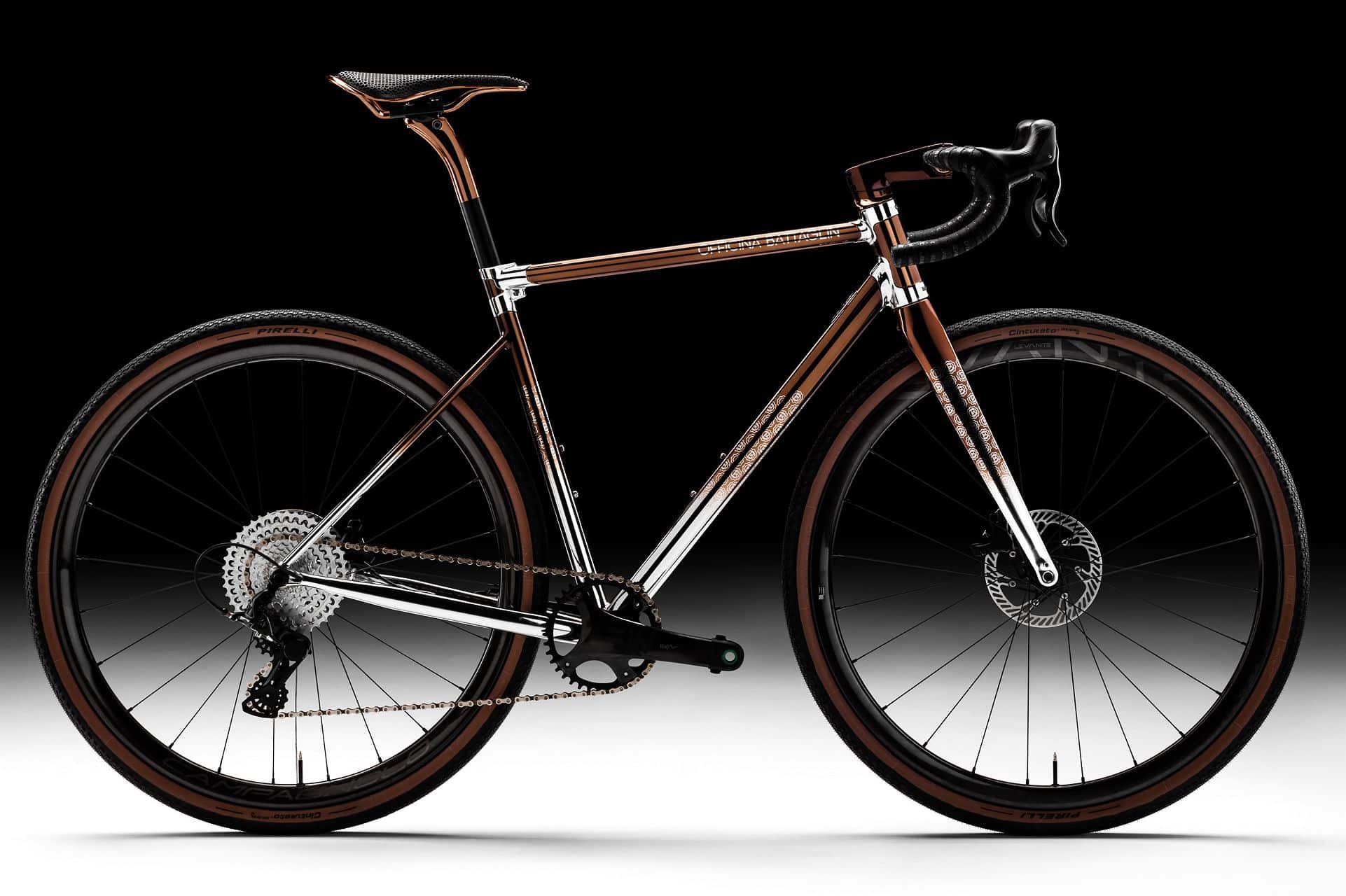
(Art on wheels)
Battaglin has unveiled its latest masterpiece, the handmade Portofino Gravel, an evolution of its renowned Portofino R road bike.
This Italian beauty is specifically designed for the iconic dirt roads of Italy, from olive groves to Tuscany’s white gravel pathways.
More than just a bike, the Portofino Gravel captures the essence of a swift ride on diverse terrains, blending the elegance of steel with the spirit of adventure.
Distinctive in its design, the Portofino Gravel boasts a tire clearance of up to 700 x 40mm, placing it in the fast gravel category, yet retaining Battaglin’s signature “road racing DNA”.
Modern features like internal cable routing and a straight 1.5″ headtube, designed for gravel, harmoniously meld with the vintage allure of custom oversized steel lugs and lightweight tubing.
This synergy promises an unparalleled ride experience reminiscent of the brand’s storied racing heritage.
A true limited edition, only 70 of these exquisite bikes will be available in 2023.
Starting at 5000€ for the frameset, complete builds are projected between 8000-8500€.
With a plethora of customization options reflecting Battaglin’s commitment to luxury and craftsmanship, the Portofino Gravel is not just a bike, but a testament to Italian artistry.
State Bicycle Co 4130 All-Road ($900 Steel Gravel Bike)
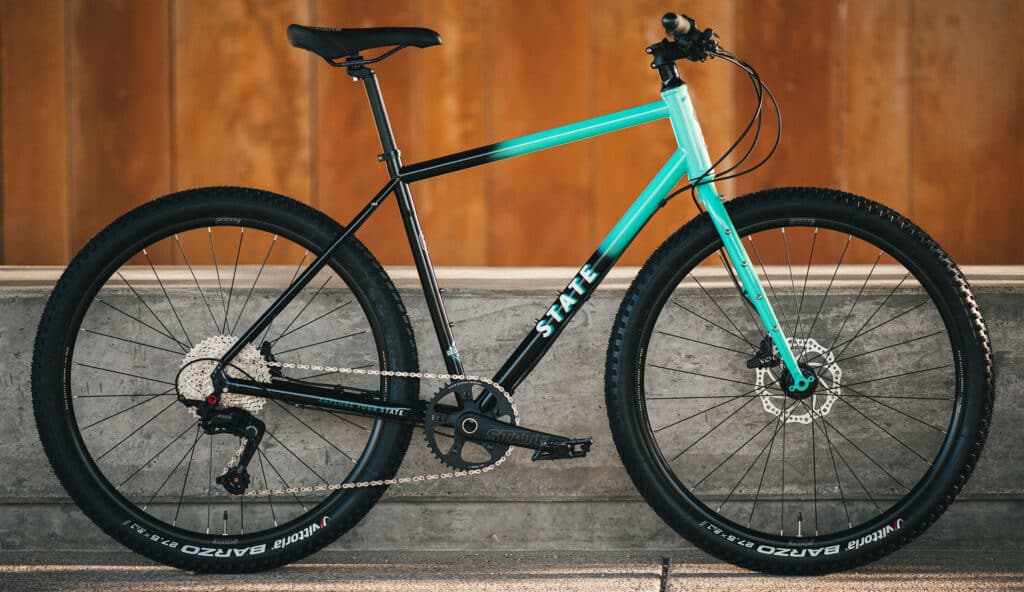
(Another Budget-Friendly Steel Gravel Bike)
| Spec | Value |
| Price | From $899 |
| Weight | 25 pounds (11.30 kg) |
| Low Gear Ratio (Climbing) | 29″ |
| High Gear Ratio | 111″ |
| Groupset / Component Spec Level | Average/Mid-Range |
| Tire Clearance | 53 mm or 2.1″ |
| Upright Ranking (Stack/Reach Ratio) | 1.62 (Very Upright) |
| Front Ride Feel (Trail) | 64.1 (Mid/Predictable) |
| Rear Ride Feel (Chainstay) | 450 (Long/Chill) |
A full-fledged Chromoly steel gravel bike at a delicious price tag! This $900 steel gravel bike could be one of the best bikes on this list.
You can run slicks or knobby tires for 700c and 650b wheels, depending on where you want to ride. With a versatile front fork with many cargo cage braze-ons for all the hauling you need.
Featuring State Bicycle Co’s own 1 x 11 drivetrain, which gives you a 42 t front crank and 11-42 at the rear. With the 650b x 2.1″ tires, this results in a climbing gear of 27.19″, which is somewhat limited for a gravel bike.
But this might be the smart choice for a bargain price of $899.99 if you plan to ride long, straight gravel roads.
I struggled to find accurate information on this bike’s geometry. But some owners recommend this for a bikepacking bike. The long rear end helps it track straight and not feel twitchy. Also available in a flat bar build.
The 42-tooth crank at the front is too large, in my opinion. And I would change it out for a smaller one, say 36t, to get better climbing results. Other than that an excellent pickup for such a low price.
The Ultimate List of Steel Gravel Bikes

In the ever-evolving landscape of gravel biking, steel frames have stood the test of time, offering an unparalleled blend of durability, comfort, and timeless aesthetics.
Whether you’re a seasoned gravel grinder, a bikepacking enthusiast, or simply appreciate the soulful ride quality that only steel can provide this comprehensive list showcases the vast array of steel gravel bikes available in the market.
From bespoke custom frames to offerings by established and emerging brands, here’s the ultimate list of steel gravel bikes, curated to guide you in finding the perfect steel steed for your next adventure.
- All City (e.g., Gorilla Monsoon, Space Horse)
- Black Mountain Cycles
- Bombtrack
- Breadwinner
- Breezer
- Brother
- Chumba
- Cinelli (e.g., Nemo Gravel)
- Condor (e.g., Bivio)
- Crust
- Curve
- Elephant (e.g., NFE)
- Endpoint (e.g., Hunter Gatherer)
- Fairlight (e.g., Secan)
- Fitz Cyclez
- Genesis (e.g., Croix de Fer 30)
- Jamis (e.g., Renegade lineup)
- Kona (e.g., Sutra LTD, Rove DL)
- Landyachtz
- Loca Bikes
- Lyonsport (e.g., L’avecaise Rando)
- Marin (e.g., Nicasio 2)
- Mason
- Maverick
- Milwaukee (e.g., Mettle/Fugitive)
- Niner (e.g., RLT 9 Steel)
- Norco (e.g., Search Steel)
- Otso
- Panorama Cycles
- Passoni
- Penhale (e.g., Gypsy)
- Rawland (e.g., Ravn, Ulv)
- Ribble (e.g., Gravel 725)
- Ritchey (e.g., Outback)
- Rodeo Labs (e.g., Flaanimal)
- Salsa (e.g., Fargo)
- Soma (e.g., Wolverine)
- Sonder
- Sour Bikes
- Standert
- Surly (e.g., Midnight Special)
- Temple (e.g., Adventure Disc)
- Tumbleweed
- Twin Six (e.g., Rando)
- VO (e.g., Polyvalent, Pass Hunter)
- Wilde
This list reflects the diverse world of steel gravel biking, offering something for every rider, from those seeking the rugged functionality for off-the-beaten-path adventures to cyclists drawn to the aesthetic and tactile pleasure of a steel frame. Each brand and model brings its unique take on how steel can enhance the gravel riding experience, ensuring that there’s a perfect match for every preference and riding style out there.
Why Ride Steel? (Are Steel Gravel Bikes Good?)
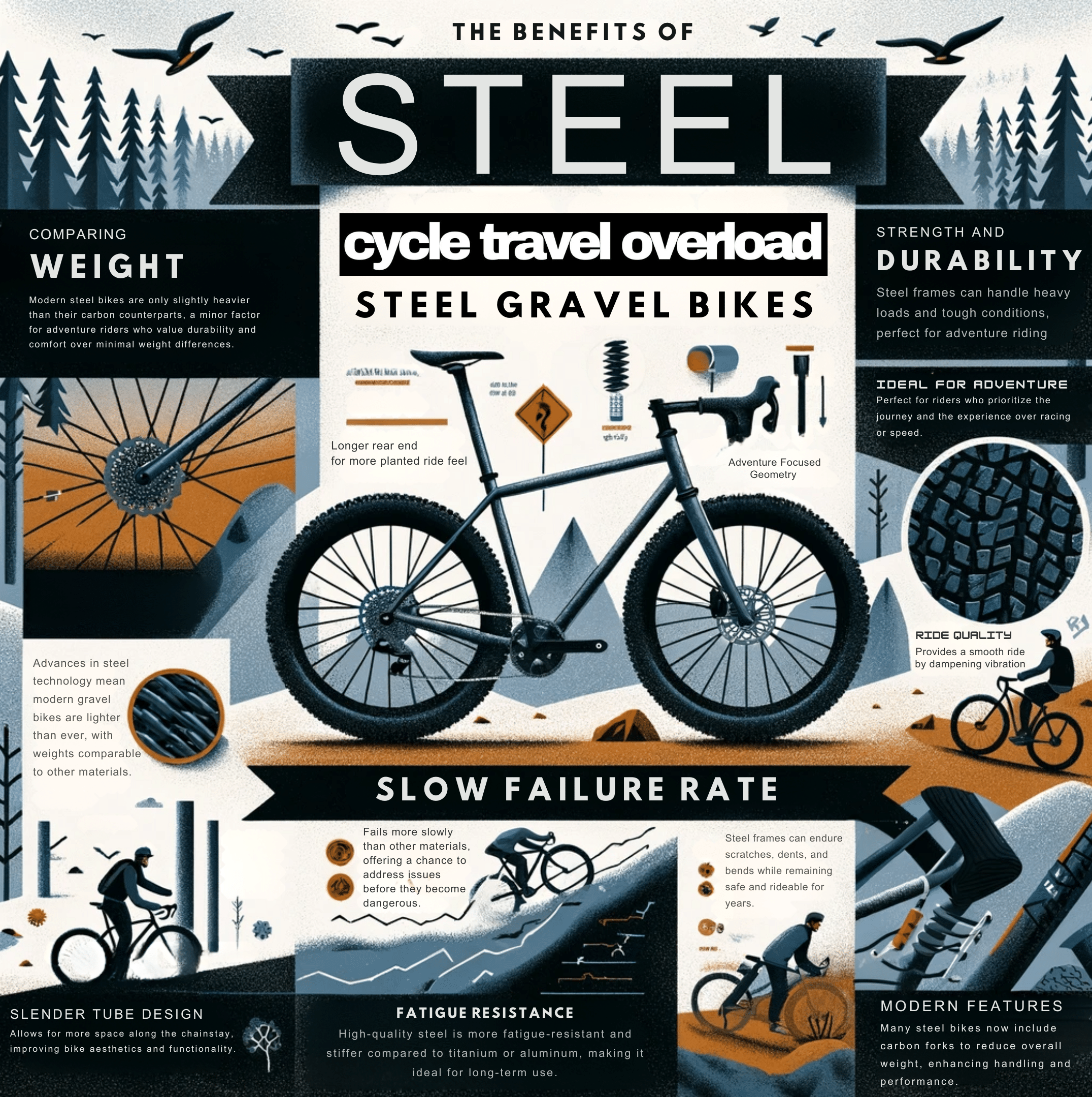
- Strength & Durability: Steel frames can handle heavy loads and tough conditions, perfect for adventure riding.
- Fatigue Resistance: High-quality steel is more fatigue-resistant and stiffer compared to titanium or aluminum, making it ideal for long-term use.
- Lightweight Modern Steel: Advances in steel technology mean modern gravel bikes are lighter than ever, with weights comparable to other materials.
- Slender Tubing Design: Allows for more space along the chainstay, improving bike aesthetics and functionality.
- Durability for Adventure: Steel frames can endure scratches, dents, and bends while remaining safe and rideable for years.
- Slow Failure Rate: Steel fails more slowly than other materials, offering a chance to address issues before they become dangerous.
- Ride Quality: Steel provides a smooth ride by dampening vibration better than aluminum, offering comfort and reducing shock to the rider.
- Modern Features: Many steel bikes now include carbon forks to reduce overall weight, enhancing handling and performance.
- Weight Comparison: Modern steel bikes are only slightly heavier than their carbon counterparts, a minor factor for adventure riders who value durability and comfort over minimal weight differences.
- Ideal for Adventure & Exploration: Perfect for riders who prioritize the journey and the experience over racing or speed.
Personally, I have a thing for steel bikes, and apart from having so much fun putting this article together. I have found there to be some really great benefits to opting for a steel-built bike!
Finding the perfect balance between cost, durability, and flexibility is where steel bikes truly shine. The hype surrounding steel bikes is well-founded – steel is real!
You would think that high-tech frame materials like carbon, aluminum, and titanium are taking the cycling scene by storm these days.
But I am happy that steel is still being used by adventure bike manufacturers, and they still see the importance of the old-school material.
In terms of volume, steel frames require less material compared to other materials, making them uniquely efficient. However, when considering weight, steel stands out as the heaviest option.
This paradox allows for steel frames to have exceptionally thin walls and smaller tube diameters.
Imagine compressing equivalent frames made of steel, titanium, aluminum, and carbon fiber into compact balls, devoid of any air space.
The steel frame, when condensed in this manner, would occupy the smallest volume, despite being the heaviest among them.
Steel bikes just have this certain “snap” – riding characteristic – about them, that is just different with other materials.
When I first got into exploring by bike, I was touring, and touring bikes are mostly made from steel due to the demands of generally carrying heavy loads and hauling all your gear.
You need a bike that has the strength for many days in the saddle.
Some of the better steel used for bike frames are more fatigue-resistant and stiffer for a given volume than titanium or aluminum.
This is why you may see some of the well-built steel bikes with slender tubing. Not all steel frame bikes are built with really skinning tubing, but for bikes like Surly, the slender design helps provide more valuable space along the chainstay between the tire and cranks.
Along with strength, steel bikes offer toughness or durability.
Making them built for adventure riding. You can scratch up, dint, and bend steel frames but still ride the bike for years and years.
This material is less affected by the abuse expected when you are out there on the trails. Also, steel fails relatively slowly, giving you a chance to fix a crack or a bend before it becomes dangerous.
Steel gravel bike weight was a downside for a while.
But I believe it is a thing of the past.
For example, I own the Kona Sutra LTD 2020, and when I was shopping around, and picked this thing up at the bike shop. I was so surprised by how light it was.
Now steel is not going to be as lightweight as carbon or potentially Titanium and Aluminum.
But it is up there with these materials nowadays! Most of the more modern steel gravel bikes are around the 10kg (22 pounds) to 13 kg (28.5 pounds) range. Thanks to the likes of thinner tubing.
Also, some of the bikes in this list have a carbon fork combo with a steel frame, which makes the overall weight lighter.
Also, with modern high-end, high-tech steel, the wall thickness can be as thin as a can of coke.
Furthermore, on weight, a steel bike probably weighs about 2-3 kg more than the equivalent carbon bike. And we are all about adventure riding more so than racing.
But if you are into bikepacking races or riding fast gravel. Steel still provides a viable option, with all the added accessories to your bike like pedals, body weight, other gadgets, bikepacking bags, and gear.
That little extra weight really would not matter too much. And certainly doesn’t matter to me as someone who is just out there to explore.
Recommended Article: Best Gravel Bikes For Touring!
Then you have ride quality!
Many people who love steel will talk to you non-stop about how well it handles, even myself! Don’t get me started!
It’s as if it has a soul! Combing responsiveness and comfort all in one.
It’s this sensory responsiveness that you don’t often get with other materials that connect you to the bike and therefore your environment that much more.
Steel rides with stiffness, comfort, and liveliness. From experience with my 2020 model gravel/adventure bike, it glides over the really rough stuff like floating on clouds! Yes, along with the suppleness of chunky MTB tires.
Combined with a steel frame. That is strong and flexible, you experience comfort and it is rather easy on your joints.
Steel dampens vibration better than aluminum and doesn’t transmit as much shock through the frame to the rider, creating a smoother ride feel.
The Modernization of Steel Gravel Bikes

The landscape of steel as a material for bike frames underwent a significant transformation in the late 1990s, marked by the introduction of air-hardened steel tubesets.
This innovation began with the release of 853, followed by other notable alloys like OX Platinum, Spirit, and ThermLX. These advanced steel alloys boasted enhanced strength, allowing frame builders to utilize thinner tubing in the construction of bike frames.
The result was frames that were not only lighter but also more responsive to the rider’s input, transforming the riding experience.
As the evolution of steel continued, the industry saw the introduction of martensitic stainless tubesets such as 953, 931, and XCr.
These materials pushed the boundaries even further, offering even greater strength. However, their rarity has made them a less common sight in the market.
This leap in material science means that if you’ve ever ridden a steel frame and found it lacking, it’s worth noting that not all steel bikes are created equal.
The advancements in steel technology have significantly diversified the capabilities and performance of steel frames, especially in the realm of gravel biking.
Today’s modern steel gravel bikes are a testament to this evolution, combining the classic appeal of steel with cutting-edge engineering to meet the demands of the modern cyclist.
These bikes offer a blend of durability, comfort, and performance that is hard to match, making steel an ever-relevant choice in the construction of versatile and enduring gravel bikes.
Do steel gravel bikes fatigue?

In the exploration of steel bike fatigue, a comprehensive study detailed in the article “Fatigue life analysis of steel bicycle frame according to ISO 4210” by Tomasz Tomaszewski delves into the endurance of steel frames under operational loads.
This research is pivotal in understanding how steel, a material long revered for its resilience and flexibility, stands up against the rigors of cycling, particularly when juxtaposed with materials like carbon and aluminum, which are also prevalent in bike manufacturing.
The study focuses on a bicycle frame constructed from 25CrMo4 steel, a low-alloy steel alloyed with chromium and molybdenum, known for its excellent balance between mechanical properties, weight, and cost.
This material choice is instrumental in producing thin-walled tubes that offer high durability and reduced weight, making it a staple in bicycle frame construction.
Through high-cycle fatigue tests conducted on mini-specimens from both the joint material and the base material of the frame, the investigation aimed to quantify the fatigue life under real-world conditions.
These tests, aligned with the ISO 4210 standard, are designed to ensure the safety and reliability of bicycle frames by simulating the stresses and loads a bike would typically endure.
One of the study’s critical findings is that fatigue life is significantly influenced by the actual loading conditions a bicycle experiences.
The cyclic nature of these loads, particularly at structural nodes under heavy stress, can initiate fatigue cracks that compromise the frame’s integrity.
The analysis revealed that even with advanced steel alloys, the risk of fatigue failure exists, underscored by the detection of fatigue cracks at the connection between the top tube and the seat stays after three years of use in gravity mountain biking.
Comparatively, materials like carbon and aluminum offer different fatigue characteristics. Carbon frames, while lighter and able to be engineered for specific performance attributes, can be more susceptible to catastrophic failure upon impact due to their stiffness and the nature of carbon fiber.
Aluminum, on the other hand, provides a balance between weight and durability but may not offer the same level of fatigue resistance as high-quality steel, especially in the context of long-term stress and load-bearing.
The study’s utilization of finite element analysis (FEA) and probabilistic Weibull models to estimate fatigue life sheds light on the complex interplay between material properties, design choices, and real-world usage patterns.
It highlights the importance of considering mean stress effects and the size effect in fatigue evaluations, which are crucial for accurately predicting the longevity and reliability of steel bicycle frames.
In conclusion, while steel bikes exhibit a remarkable fatigue life, particularly with advancements in steel technology, they are not immune to fatigue failure.
The operational conditions and the forces exerted on the bicycle significantly impact the longevity of the frame.
This research underscores the necessity of meticulous design, material selection, and manufacturing processes to optimize the fatigue strength of steel bicycles, ensuring they meet the rigorous standards set forth by ISO 4210 and cater to the demands of modern cyclists.
Pros and Cons of Steel Gravel Bikes
Pros
- Ideal balance between cost, durability, and ride compliance
- In the event of damage, steel frames are much easier to repair than those made from materials like carbon fiber. Which is a major benefit for long bike trips. Ease of repairability is ideal with limited serviceability options on the road.
- By volume, steel frames use less material than those made from titanium, aluminum, or carbon fiber, showcasing unique material efficiency.
- Steel design allows for paper-thin tubing walls and smaller tube diameters, resulting in a compact volume.
- Boast a classic, timeless look! The aesthetic appeal, combined with modern manufacturing techniques, bridges the gap between tradition and contemporary performance. Perfect for those who have a connection to nostalgia.
- Manipulative material for custom bike builds. personalized geometry and design, catering to riders’ specific preferences and needs can be achieved with steel.
Cons
- Steel is a heavier material compared to titanium, alloy, and carbon. Can feel less agile and require more effort to pedal, especially on uphill climbs or when acceleration is needed.
- Limited availability might be a concern with steel bikes. Not always true, but high-quality steel frames, can be less readily available in mainstream bike shops and may require seeking out specialty manufacturers or custom builders.
Aluminum, Carbon or Steel? Which is best for a gravel bike?

Choosing the right material for a gravel bike boils down to comparing steel, carbon, and aluminum. Steel offers a smooth ride and timeless appeal but is heavier.
Carbon is lightweight and stiff, perfect for performance, though it can be costly and less durable upon impact.
Aluminum provides a middle ground with good durability and a lighter feel than steel, all while being more affordable.
This brief comparison highlights the key differences to help guide your choice for the ultimate gravel biking experience
| Feature/Aspect | Steel Gravel Bikes | Carbon Gravel Bikes | Aluminum Gravel Bikes |
|---|---|---|---|
| Weight | Cons: Typically heavier than carbon and aluminum. | Pros: Lighter than steel in general. | Pros: Lighter than steel but generally heavier than carbon. |
| Ride Feel | Pros: Offers a smooth, compliant ride due to natural damping qualities. Cons: Less stiff than carbon. | Pros: Can be engineered for specific stiffness and compliance. Cons: Some find it to have a less “lively” feel. | Pros: Stiffer than steel, offering precise handling. Cons: May transmit more road vibration. |
| Durability | Pros: Robust and can handle minor dings and impacts without structural compromise. | Cons: Can be damaged easily with sharp impacts. Damage might be invisible, leading to potential issues. | Pros: Durable and less prone to catastrophic failure than carbon. |
| Cost | Pros: Generally less expensive than carbon frames. Cons: High-end steel can be costly. | Pros: High performance-to-weight ratio. Cons: Typically more expensive. | Pros: Often more affordable than carbon, offering a good balance of cost and performance. |
| Repairability | Pros: Easier to repair with welding if damaged. | Cons: Difficult to repair, often requiring a replacement. | Pros: More challenging to repair than steel but easier than carbon. |
| Corrosion | Cons: Prone to rust if not properly cared for or if the paint is chipped. | Pros: Doesn’t rust or corrode. | Pros: Doesn’t rust like steel. Cons: Susceptible to corrosion if protective coatings are compromised. |
| Aesthetics | Pros: Classic, timeless look. Cons: Limited to tube-like shapes. | Pros: Allows for more innovative and aerodynamic designs. Cons: Some prefer the look of traditional materials. | Pros: Modern and sleek designs are possible. Cons: Some find the aesthetic less warm than steel. |
| Environmental Impact | Cons: Mining and processing of steel has environmental implications, though steel is highly recyclable. | Cons: Carbon production is energy-intensive and recycling is challenging. | Cons: Aluminum processing is energy-intensive, but the material is recyclable. |
| Modularity & Customization | Pros: Easier to make custom geometries and modify them. | Cons: Less modular; customization requires complex molds. | Pros: Allows for some level of customization, though not as flexible as steel. |
| Fatigue Life | Pros: Steel has an indefinite fatigue life if not corroded. | Cons: While carbon has a long fatigue life, it’s not as indefinite as steel. | Pros: Good fatigue life, but can be susceptible to stress cracks over time. |
Are steel gravel bikes slow?

The notion that steel gravel bikes are inherently slow is a misconception.
While it’s true that steel frames are generally heavier than their carbon or aluminum counterparts, the overall speed of a bike is influenced by various factors, including the bike’s geometry, tire rolling resistance, the rider’s efficiency, and the specific conditions of the ride and so many other variables.
Steel gravel bikes offer a unique blend of durability, comfort, and versatility, making them highly capable over a wide range of terrain.
The slightly increased weight of a steel frame can contribute to a steadier ride over rough surfaces, which can improve a rider’s average speed on gravel or mixed-terrain routes by enhancing control and reducing fatigue.
Additionally, the “springiness” or natural flex of steel can provide a more comfortable ride, allowing riders to maintain higher speeds for longer periods without discomfort.
In essence, while steel gravel bikes might not match the top-end speed of a lightweight carbon racer on smooth roads, they are by no means slow, especially in the context of gravel riding where comfort, stability, and endurance are equally important for maintaining a good pace.
Other Gravel Bike Articles You Might Be Interested In
Listed below is some more reading about gravel bikes if you are interested!
- Best Gravel Bikes Under $1000 in 2022
- Best Titanium Gravel Bikes 2022
- Best 22 Flat Bar Gravel Bikes In 2022
- Gravel Bike VS Touring Bike – What Is The Difference?
- 17 Lightest Gravel Bikes You Can Buy!
- Best Gravel Bike Clothing
About The Author
One thought on “Best Steel Gravel Bikes – Everything You Need To Know!”
Comments are closed.

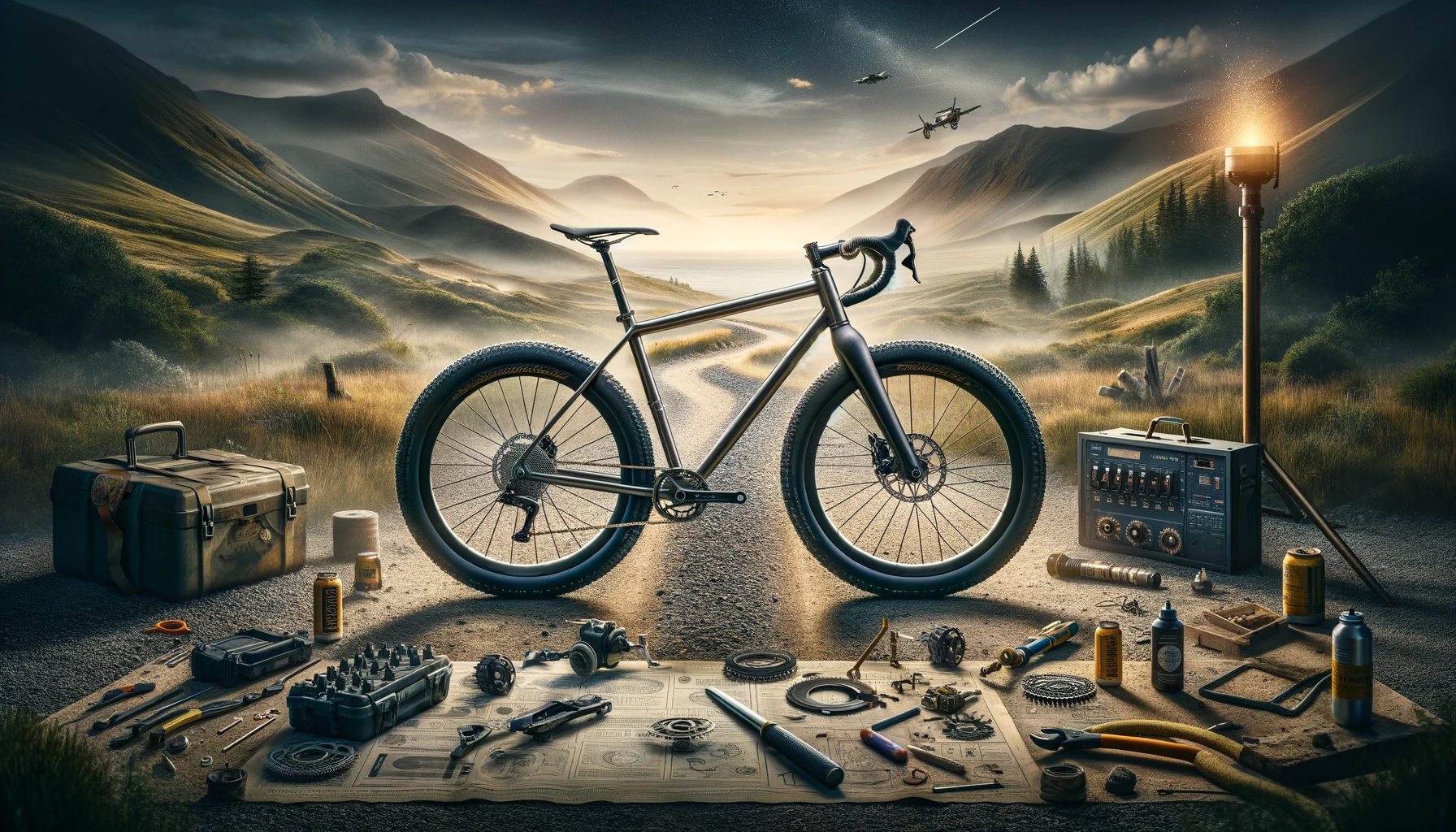
This a a very good brand from brasil, simple gravel bike, make whit care. https://dinamicabicicletas.com.br/guara.html